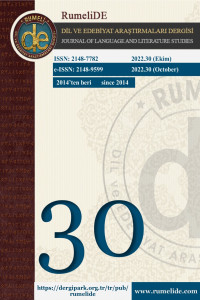Öz
Bu çalışma, COVID-19 salgını sırasında Türkiye’de bir devlet üniversitesinde uzaktan eğitim moduyla tercüman eğitiminde öğrenci bakış açısını keşfetmeyi amaçlamaktadır. Üç bölümden oluşan çevrimiçi bir anket yapılmıştır. Katılımcılar Mütercim-Tercümanlık lisans programına kayıtlı ve çevrimiçi sözlü çeviri dersleri almış üçüncü ve son sınıf öğrencileridir. Sonuçlar, öğrenciler kayıtlı dersleri daha sonra izlemek gibi avantajları sevdiğini belirtse bile, çoğu öğrencinin bu dersleri 'sıkıcı' bulduklarını ve odaklanmakta zorlandıklarını göstemiştir. Bu sebepten dolayı bu derslerin genel anlamda sözlü çeviriye yardımcı olmadığını düşünen öğrenciler çevrimiçi sözlü çeviri derslerine katılmaktan hoşlanmadıklarını belirttiler. Teknik sorunlar, iletişim ve bilgi teknolojilerindeki gelişmelerin yardımıyla büyük ölçüde ortadan kaldırılsa da, dikkat eksikliği gibi uzaktan öğrenmede bulunan bazı genel sorunlar bu derslerde de mevcuttur. Kısa bir literatür taramasının ardından, bu makale, öğrencilerin sözlü çeviri eğitiminde uzaktan öğrenmeye ilişkin bakış açısını sunmaktadır. Buna ek olarak ortaya çıkan veriler dahilinde yeni araştırma imkanlarını ortaya koymaktadır.
Anahtar Kelimeler
Kaynakça
- Güven, M. (2014). Distance learning as an effective tool for medical interpreting training in Turkey. Open Learning, 29(2), 116–130. https://doi.org/10.1080/02680513.2014.964196
- Ko, L. (2006). Teaching interpreting by distance mode: Possibilities and constraints. Interpreting: International Journal of Research and Practice in Interpreting, 8(1), 67–96. https://doi.org/10.1075/intp.8.1.05ko
- Ko, L. (2008). Teaching interpreting by distance mode: An empirical study. Meta, 53(4), 814–840. https://doi.org/10.7202/019649ar
- Kurz, I. (2003). Physiological stress during simultaneous interpreting: A comparison of experts and novices. THE INTERPRETERS' NEWSLETTER, (12), 51-68.
- Geri, Nitza & Winer, Amir & Zaks, Beni. (2017). A Learning Analytics Approach for Evaluating the Impact of Interactivity in Online Video Lectures on the Attention Span of Students. Interdisciplinary Journal of e-Skills and Lifelong Learning. 13. 215-228. 10.28945/3875.
- Mackintosh J. (2002): "Workload Study. Main results and what they mean", AIIC Bulletin XXXII/1, pp. 15-16.
- Mertens-Hoffman (2001): A Study of Workload and Burnout in Simultaneous Interpreting. Integrative Summary Report, Tel-Aviv, Mertens Hoffman
Öz
This study aims to explore the student perspective in interpreter training by distance learning mode at a state university in Turkey during the on-going COVID-19 pandemic. An online survey consisting of three sections was conducted. Participants were junior and senior students enrolled in Translation and Interpreting undergraduate program and who had taken online interpreting classes. The results show that while some advantages are favored by students such as watching recorded classes later, most students do not like attending online interpreting classes because they find these classes ‘boring’, harder to focus on and do not think these classes help their overall interpreting classes. Although technical problems are mostly eliminated with the help of advancements in communication and information technologies, some inherent problems surrounding distance learning such as attention deficiency remain intact. Following a brief literature review, the present paper provides the student perspective on distance learning in interpreter training and based on the findings, puts forth ways for further research.
Anahtar Kelimeler
Kaynakça
- Güven, M. (2014). Distance learning as an effective tool for medical interpreting training in Turkey. Open Learning, 29(2), 116–130. https://doi.org/10.1080/02680513.2014.964196
- Ko, L. (2006). Teaching interpreting by distance mode: Possibilities and constraints. Interpreting: International Journal of Research and Practice in Interpreting, 8(1), 67–96. https://doi.org/10.1075/intp.8.1.05ko
- Ko, L. (2008). Teaching interpreting by distance mode: An empirical study. Meta, 53(4), 814–840. https://doi.org/10.7202/019649ar
- Kurz, I. (2003). Physiological stress during simultaneous interpreting: A comparison of experts and novices. THE INTERPRETERS' NEWSLETTER, (12), 51-68.
- Geri, Nitza & Winer, Amir & Zaks, Beni. (2017). A Learning Analytics Approach for Evaluating the Impact of Interactivity in Online Video Lectures on the Attention Span of Students. Interdisciplinary Journal of e-Skills and Lifelong Learning. 13. 215-228. 10.28945/3875.
- Mackintosh J. (2002): "Workload Study. Main results and what they mean", AIIC Bulletin XXXII/1, pp. 15-16.
- Mertens-Hoffman (2001): A Study of Workload and Burnout in Simultaneous Interpreting. Integrative Summary Report, Tel-Aviv, Mertens Hoffman
Ayrıntılar
| Birincil Dil | İngilizce |
|---|---|
| Konular | Dilbilim |
| Bölüm | Çevirilbilimi |
| Yazarlar | |
| Yayımlanma Tarihi | 21 Ekim 2022 |
| Yayımlandığı Sayı | Yıl 2022 Sayı: 30 |

